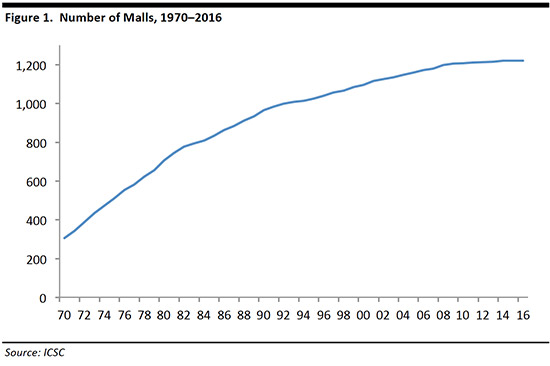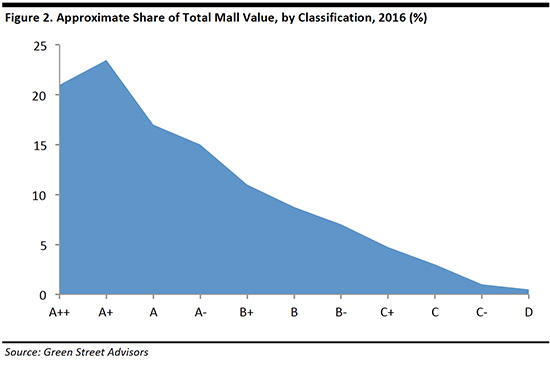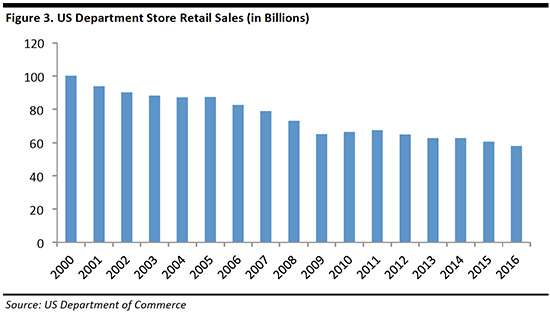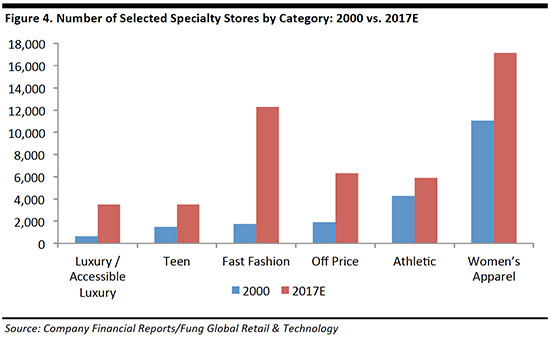
Preview: The Mall Is Not Dead Series

KEY POINTS
- Fung Global Retail & Technology published the first installment of our The Mall Is Not Dead series in November 2016, which analyzed the changing US mall landscape and mall traffic.
- The next report in the series, to be published in the coming weeks, takes a deeper dive into the mall landscape and examines the specialty store and department store channels in light of what seem to be near-daily announcements of store closures and bankruptcy filings.
- In our final report in the series, to be published later this year, we will explore what the “mall of the future” might look like and examine the important roles technology and retail will play in malls in the coming years.
This is a preview of the next report in our The Mall Is Not Dead series. The first report in the series was published in November 2016. In that report, we noted that malls across the US have been facing difficulties for some time. According to RetailNext, mall traffic in the US has decreased for 43 consecutive months, and it continues to be challenging. Malls have seen an average decrease in traffic of 8.0% per month since January 2015. In addition, there seem to be almost daily announcements of retailers closing a significant number of stores and others filing for bankruptcy. These trends prompt a number of questions: What does all this mean for the future of the mall? Will malls even exist in 10 years? Will the mall of the future be vastly different from the mall of today?
In our second report in the series, to be published in the coming weeks, we dive deeper into the mall landscape, analyzing the factors affecting malls and look at the mall composition including department stores and specialty stores. In the third report in the series, to be published later this year, we will look at the mall of the future and the technology that will drive the consumer experience there. We will also explore the future roles of retail, entertainment, experiences and food in malls.
Overall, we are optimistic that the future of retail will be driven by technology that enables exciting possibilities for engaging consumers’ senses. Stay tuned for the remaining reports in our The Mall Is Not Dead series.
Part One Review: Mall Traffic Is Declining and 30% of Traditional Malls Are Likely to Close
Traditional malls are being challenged. There is now an excess of malls in the US, mostly within the C and D property classifications. According to the International Council of Shopping Centers, there are currently 1,221 malls in the US, and their number increased by more than 300% between 1970 and 2016.

We believe that at least 30% of malls need to be closed. Malls classified as A properties are the most productive; they account for only 20% of all malls, yet represent 72% of total mall sales, as shown in the figure below.

The top 10 malls in the US see average sales per square foot of over $1,000, which is more than twice the mall average. Sales at A malls have grown by double digits in the past five years, and most A malls are in urban or tourist areas.
Part Two Preview: Department Stores and Specialty Stores in a Changing World
The department store channel has faced significant challenges and sustained periods of falling sales. According to the US Department of Commerce, department store sales have declined by 30% since 2005, as shown in figure 3.

Beginning in the 1990s, consumers started to become very interested in brands with specific identities and customer niches, and moved away from the ‘everything under one room’ concept. Figure 4 highlights the number of selected specialty stores by category in 2000 and 2017. Fast-fashion stores have increased by 596% and off-price stores have increased by 232%.

The fast-fashion industry has changed consumers’ expectations―they now demand that new, on-trend merchandise be available every few weeks instead of every few months as in the past. Furthermore, the off-price sector is changing the way consumers shop, by providing discovery and value shopping. These changing demands have impacted mass-market retailers, and e-commerce and the prevalence of niche brands are increasingly upping the competition.
One of the biggest challenges for brick-and-mortar retailers today is staying current in a digital world. It is difficult for these retailers to compete with the convenience that e-commerce offers. Consumers are still using the in-store experience to complement their e-commerce shopping—more than 90% of purchases still occur in-store—but the retail landscape is evolving by the minute. Shoppers now demand more differentiated and customized products, and they want them delivered faster than ever.

Part Three Preview: The Future of Malls—the Transformation
So, how will malls remain relevant? We see them transforming in two ways. First, the retail equation will change in malls, with the emphasis shifting from retail to experiences. Today, traditional malls are focused on retail, which accounts for 80%–90% of mall space. Tomorrow, more mall space will be devoted to experiences, food, entertainment and unique events.
Second, we envision the mall of the future as one where the lines between the physical world, the virtual world and e-commerce all merge—where consumers shop using virtual-reality headsets and augmented-reality (AR) fitting rooms. This is already happening on a small scale, as some retailers are using virtual headsets to enable consumers to shop in virtual stores and others are using “magic mirrors” in fitting rooms. Although these concepts are still in their infancy, we see them expanding. The mall of the future will be more agile and flexible, but is still a work in progress.
